Geographically speaking, Oklahoma isn’t significantly large. However, the state is well-populated with some of the most interesting and diverse birds out there.
According to the Oklahoma Ornithological Society’s Bird Records Committee (OBRC), there are more than 480 recorded species of birds that you can find in the state.
If you’re interested in learning more about the variety of birds in Oklahoma, this article is for you! Today, we’ll walk you through a brief guide of the most interesting and colorful birds you’ll encounter in the Sooner State. Let’s dive in!
Red Birds in Oklahoma
Northern Cardinal

- Scientific Name: Cardinalis cardinalis
- Length: 8.3 to 9.1 inches
- Weight: 1.5 to 1.7 ounces
- Wingspan: 8.9 to 12.2 inches
The Northern Cardinal is among the most unique birds that you can find flying around your bird feeder. The males have a stunning red plumage that will immediately attract your attention.
On the other hand, females have a fainter, mostly yellowish-brown color with a reddish-orange crest, tail, and wings.
Both sexes are known for their thick orange-red bill and black face mask that extends to their throats. They look lovely and sing in beautiful tones but they’re pretty aggressive towards each other and other birds.
Downy Woodpecker

- Scientific Name: Dryobates pubescens
- Length: 5.5 to 7.1 inches
- Weight: 0.7 to 1.1 ounces
- Wingspan: 9.8 to 12.2 inches
The Downy Woodpecker is one of the smallest and most common species of woodpeckers in the state. Although it has mostly black-colored plumage, it’s known for the characteristic red patch on the back of its head.
The Downy Woodpecker is one of the most well-adapted woodpeckers to residential areas, and it’ll typically land in your backyard looking for food. Its favorite foods are fruits and seeds, but the bird can also enjoy leftovers, such as donuts!
Red-Bellied Woodpecker

- Scientific Name: Melanerpes carolinus
- Length: 9.2 to 10.3 inches
- Weight: 2.2 to 3.2 ounces
- Wingspan: 15.7 to 17.8 inches
The Red-bellied Woodpecker is another impressive bird that you can find in Oklahoma. The bird rocks an astonishing white and black-barred plumage on the back with a remarkable red patch on the head and the belly.
These woodpeckers mainly feed on fish, so you can also find them around ponds, rivers, and small bodies of water.
Pileated Woodpecker

- Scientific Name: Dryocopus pileatus
- Length: 16 to 19 inches
- Weight: 8.8 to 14.1 ounces
- Wingspan: 26 to 30 inches
The Pileated Woodpecker is a relatively large species of woodpecker that also calls the state of Oklahoma home.
They’re known for the vibrant red cap on their head and the dark plumage on most of their body. You can also note their presence by the rectangular holes they dig into nearby trees, looking for insects.
House Finch

- Scientific Name: Haemorhous mexicanus
- Length: 4.9 to 6.1 inches
- Weight: 0.6 to 0.9 ounces
- Wingspan: 8.1 to 10.5 inches
The American House Finch is another common backyard bird that you can spot in Oklahoma.
In most cases, the males of the species will have a rosy plumage extending from their heads to the wings. However, this red plumage is dependent on the bird’s diet.
But, it is exclusive to male birds, as females have a grey and brown color that dominates most of the bird’s body.
Red-Winged Blackbird

- Scientific name: Agelaius phoeniceus
- Length: 6.7 to 9.1 inches
- Weight: 1.1 to 2.7 ounces
- Wingspan: 12.2 to 15.8 inches
The Red-winged Blackbird is one of the most interesting varieties of blackbirds in America due to the vibrant red and yellow patch on the bird’s shoulders.
The rest of the bird’s body is covered with black feathers and the typical blackbird physical properties.
Like the Red-bellied Woodpecker, this bird is also commonly found around bodies of water, including marshes, lakes, and rivers. However, they mainly feed on insects in this area. Yet, they occasionally visit bird feeders for a quick meal of sunflower seeds.
Blue Birds in Oklahoma
Eastern Bluebird

- Scientific Name: Sialia sialis
- Length: 6.3 to 8.3 inches
- Weight: 0.9 to 1.2 ounces
- Wingspan: 9.8 to 12.6 inches
The Eastern Bluebird population in Oklahoma is decently high, and you can find them perching on fence posts and communication cables all over the state.
The migratory thrush is known for its colorful plumage. The bird’s head, wings, and back are blue, while the chest and throat areas are bronze with white underparts.
This unique coloration makes them quite interesting and easy to identify by beginner bird watchers.
Blue Jay

- Scientific Name: Cyanocitta cristata
- Length: 8.6 to 11.8 inches
- Weight: 2.5 to 3.5 ounces
- Wingspan: 13.3 to 16.9 inches
The Blue Jay is one of the most widespread species of birds in the state of Oklahoma. They have one of nature’s most beautiful shades of blue all over their body, especially at the wings and tail.
However, this coloration is mainly due to feather structure and light reflection, as the bird doesn’t have any blue pigment.
The noisy bird is surprisingly intelligent and capable of cracking nuts open and mimicking raptor calls to warn and scare other birds away.
Common Grackle

- Scientific name: Quiscalus quiscula
- Length: 11.0 to 13.4 inches
- Weight: 2.6 to 5.0 ounces
- Wingspan: 14.2 to 18.1 inches
The Common Grackle is a relatively large-sized blackbird with a lanky body structure and a mostly iridescent blue and turquoise plumage. The dark blue color covers most of the bird’s head and the upper portion of the chest.
The rest of the bird’s body is mainly dark bronze to black with purplish hues at the wing area.
The bird is exceptionally social and lives in large groups where members chatter loudly, making it reasonably easy to spot and identify the bird. It’s also quite resourceful and will feed on anything from fruits, seeds, and insects, to small birds and rodents!
Barn Swallow
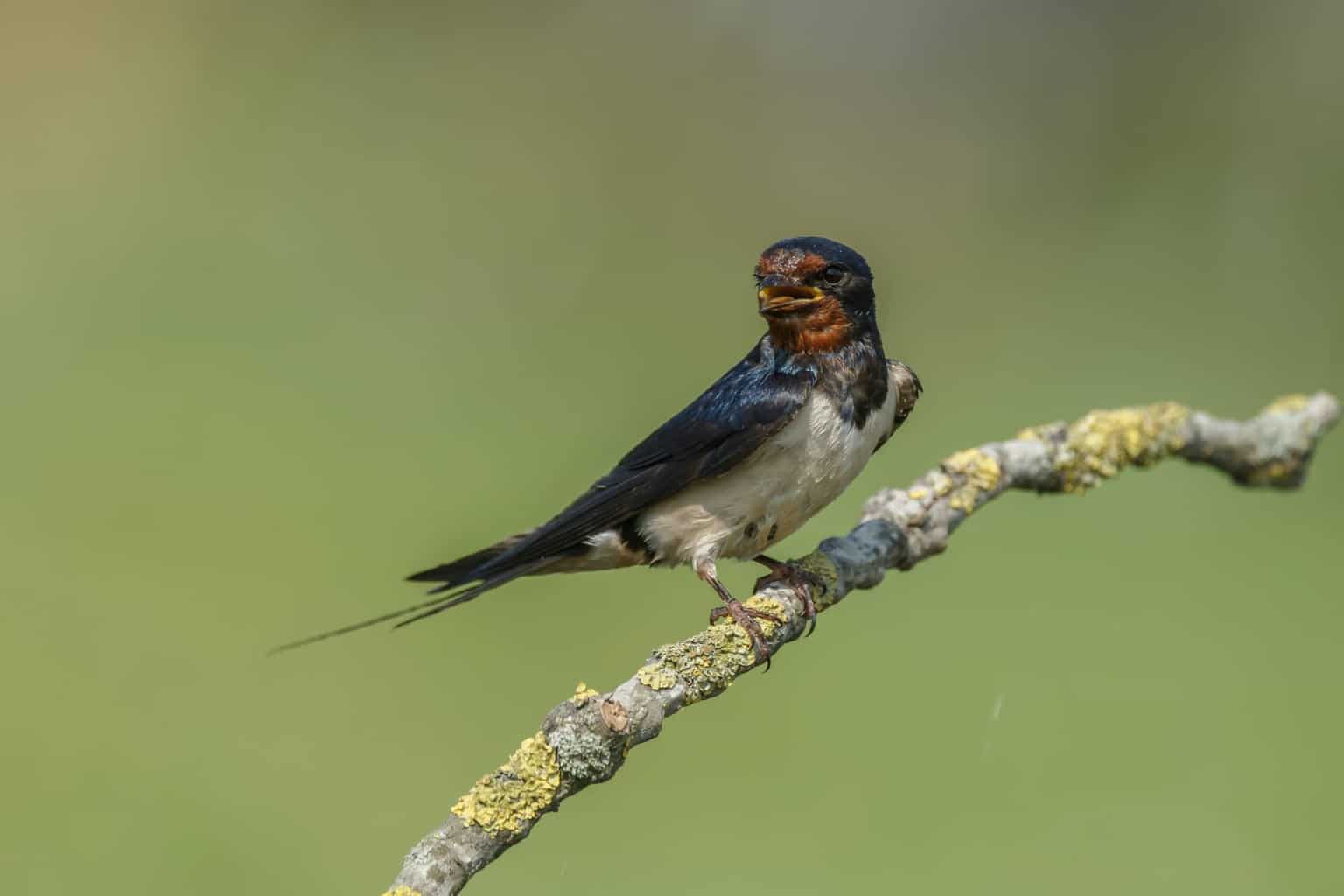
- Scientific Name: Hirundo rustica
- Length: 6.7 to 7.5 inches
- Weight: 0.56 to 0.78 ounces
- Wingspan: 12.6 to 13.6 inches
The Barn Swallow is one of the most common members of the swallow species in all of North America.
The bird has a unique steely blue plumage that covers its tail, back, and wings. You can typically find them perching on telephone wires and communication poles.
Additionally, they like to fly over meadows and open fields to find insects and other food sources like cracked eggshells.
Green Birds in Oklahoma
Ruby-Throated Hummingbird
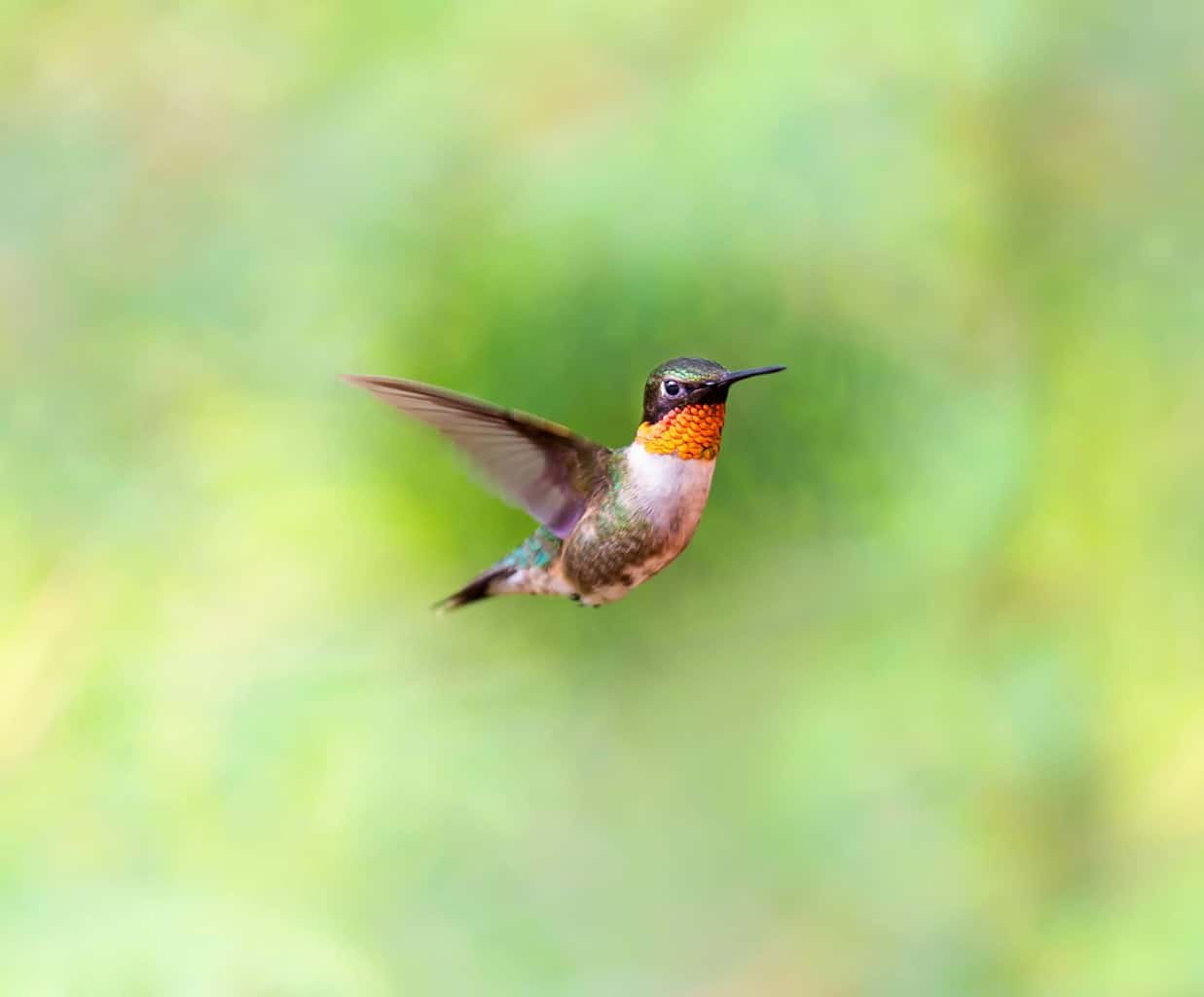
- Scientific Name: Archilochus colubris
- Length: 2.8 to 3.5 inches
- Weight: 0.1 to 0.2 ounces
- Wingspan: 3.1 to 4.3 inches
Although there are various types of hummingbirds in the state of Oklahoma, the Ruby-throated Hummingbird is among the most common and most impressive ones that you may come across there.
The male hummingbirds are known for their remarkably radiant red plumage at the throat and top of the chest and a black mask covering the bird’s face. The majority of the bird’s body is olive green.
On the other hand, females also have a faint green color, but it primarily covers their throats in streaks. However, most of the female body is buff-colored with a green wash.
Blue-Headed Vireo

- Scientific Name: Vireo solitarius
- Length: 4.7 to 5.9 inches
- Weight: 0.5 to 0.6 ounces
- Wingspan: 8.7 to 9.5 inches
Despite the name, the Blue-headed Vireo is a mostly green-colored bird, a common feature among many types of vireos in North America.
The Blue-headed Vireo is a relatively small songbird with a stocky body and a decently long tail. The bird also has remarkably thick legs when compared to similar-sized birds like new world warblers.
The bird is identified through the dark bluish-gray feathers on its head. However, most of the bird’s body is covered in pale olive green, especially at the tail, back, and wings.
Orange Birds in Oklahoma
American Robin

- Scientific Name: Turdus migratorius
- Length: 9.0 to 11.0 inches
- Weight: 2.3 to 2.8 ounces
- Wingspan: 14.7 to 16.5 inches
The American Robin is one of the most common backyard birds in the state of Oklahoma as well as most of North America.
The bird has a unique body color of rusty orange feathers that covers the bird’s underparts, including the chest and belly. The rest of the bird is dark brown to black, depending on the bird’s variety.
The bird is adapted to residential areas and is known for nesting nearby, where you can find its famous sky blue-colored eggs!
Baltimore Oriole

- Scientific Name: Icterus galbula
- Length: 5.8 to 7.8 inches
- Weight: 2.3 to 3.5 ounces
- Wingspan: 3.5 to 4.7 inches
The Baltimore Oriole is another beautiful bird that rocks a unique flaming orange coat of feathers. The color primarily covers the bird’s wings but also extends to the rump and underparts.
Females are also orange, but the color’s intensity varies, so it’s not uncommon to find a yellowish female in the same pattern.
The bird is also easy to attract as long as your bird feeder has its favorite food. They’re also drawn to mealworms and commercial nectar mixes.
Yellow Birds in Oklahoma
American Goldfinch

- Scientific Name: Spinus tristis
- Length: 4.3 to 5.5 inches
- Weight: 0.39 to 0.71 ounces
- Wingspan: 7.5 to 8.7 inches
The American Goldfinch is another ubiquitous bird that often hangs around residential areas and backyards in Oklahoma. The bird has a distinct flying pattern characterized by its bounciness.
Additionally, the bird has a remarkably vibrant yellow plumage covering all the bird’s body except the head and wings, which are black. Females have a similar pattern but with somewhat fainter colors or black patches on the head.
Western Meadowlark

- Scientific Name: Sturnella neglecta
- Length: 6.3 to 10.2 inches
- Weight: 3.1 to 4.1 ounces
- Wingspan: 16.0 to 16.3 inches
The Western Meadowlark is relatively abundant in Oklahoma as well as a few neighboring states. The bird has a medium-sized body that is as large as a robin.
You can easily identify the bird through its yellow underparts that extend from belly to throat. The bird belongs to the grassland bird family characterized by broad shoulders and relatively longer bills.
American Yellow Warbler
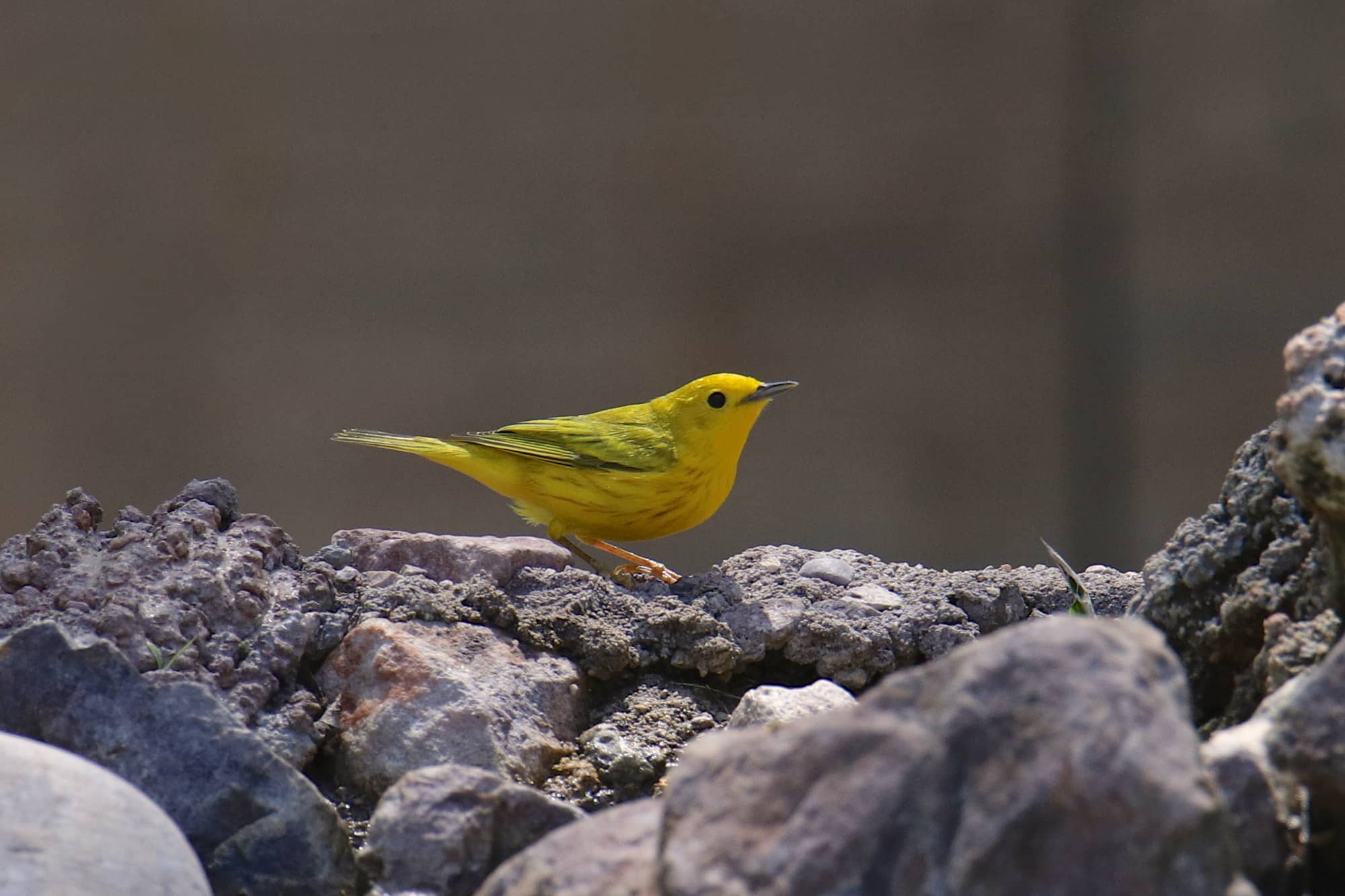
- Scientific Name: Setophaga petechia
- Length: 4.7 to 5.1 inches
- Weight: 0.3 to 0.4 ounces
- Wingspan: 6.3 to 7.9 inches
The American Yellow Warbler is among the most common birds in all of North America. The bird is characterized by its canary yellow plumage that covers most of its body. It also has a few faint touches of olive green on the back.
The bird typically forages around lakes, but you can also find them hanging around poplar forests and perching on nearby trees.
Other Birds to Watch in Oklahoma
Scissor-Tailed Flycatcher
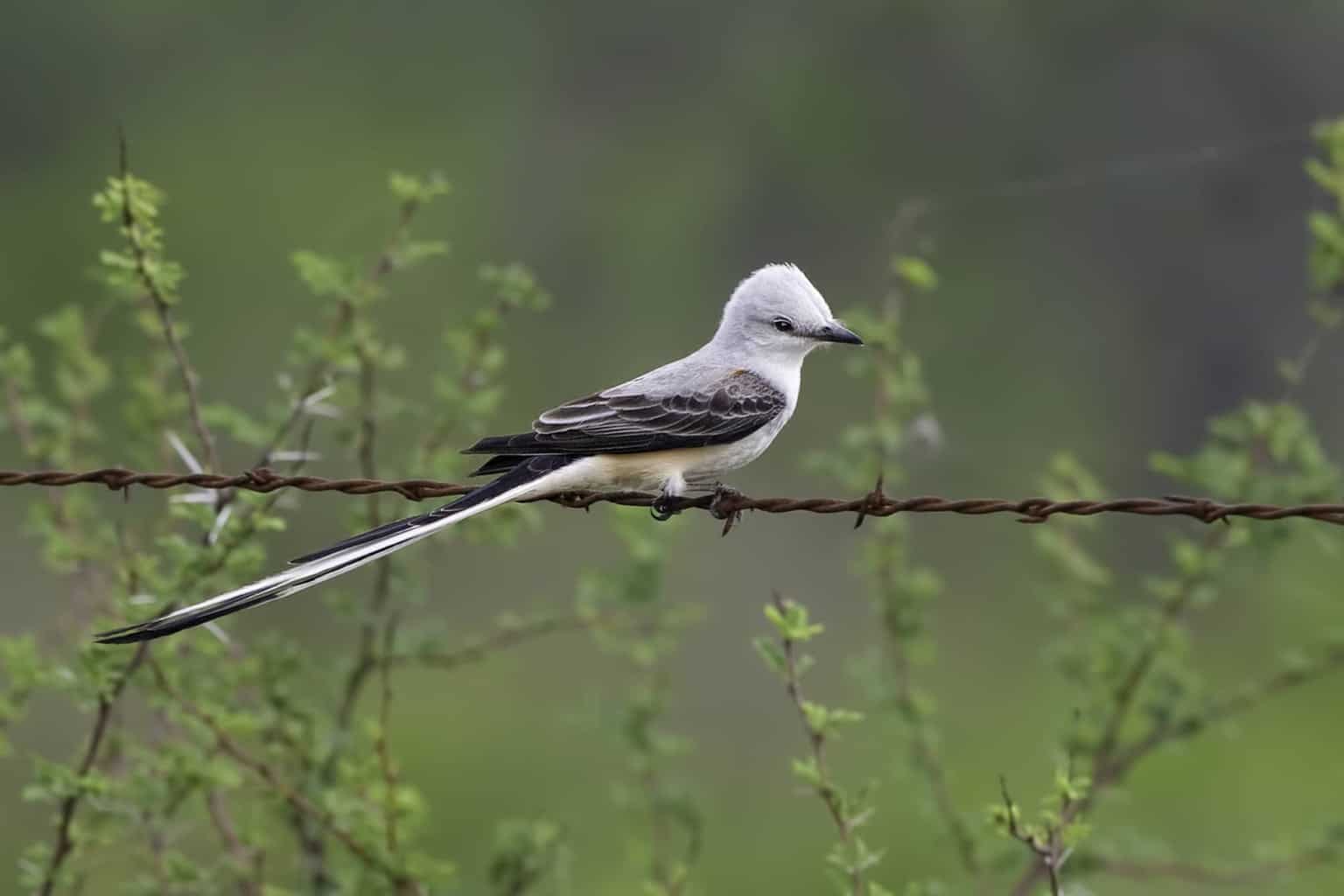
- Scientific Name: Tyrannus forficatus
- Length: 8.7 to 14.6 inches
- Weight: 1.3 to 2.0 ounces
- Wingspan: 5.7 to 6.0 inches
Of course, the list wouldn’t be complete without including the Scissor-tailed Flycatcher, as the bird is one of the most iconic birds in the state of Oklahoma and has been considered the official state bird since 1951.
One of the most characteristic features of the scissor-tailed flycatcher is its significantly long tail compared to its body’s size. The tail is also deeply forked, which makes it highly identifiable from a distance.
The bird has a white head with a black tail and wings and a salmon-orange wash on its underparts and shoulders.
Northern Flicker

- Scientific Name: Colaptes auratus
- Length: 11.0 to 14.2 inches
- Weight: 3.0 to 5.9 ounces
- Wingspan: 16.9 to 21.2 inches
The Northern Flicker is another addition to the state’s wide variety of woodpecker species. However, this one typically feeds on the ground.
Northern Flickers look similar to Red-bellied Woodpeckers. However, they lack the characteristic red plumage on the head and belly. Instead, they have brown and black plumage with the red patch found only on the bird’s cheeks.
Brown-Headed Cowbirds

- Scientific Name: Molothrus ater
- Length: 7.5 to 8.7 inches (males) – 6.3 to 7.9 inches (females)
- Weight: 1.5 to 1.8 ounces (males) – 1.3 to 1.6 ounces (female)
- Wingspan: 14.0 to 14.4 inches (males) – 10.0 to 12.6 inches (females)
This bird is native to North America and has made quite a name for itself due to its brood parasitic behavior.
Females of this species typically destroy one egg in the nests of other birds, such as robins, and replace it with their eggs. The chicks are then raised and fed by other species.
The bird has a thick bill with a brown-colored head and shiny black plumage on the rest of its body.
American Crow

- Scientific Name: Corvus brachyrhynchos
- Length: 15.8 to 20.9 inches
- Weight: 11.2 to 21.9 ounces
- Wingspan: 33.5 to 39.4 inches
The American Crow is not only common in Oklahoma, but it’s also common in various other states in the United States.
The bird is known for rocking a unique all-black feather coat. Despite popular belief, the bird is quite intelligent and friendly towards humans.
White-Breasted Nuthatch
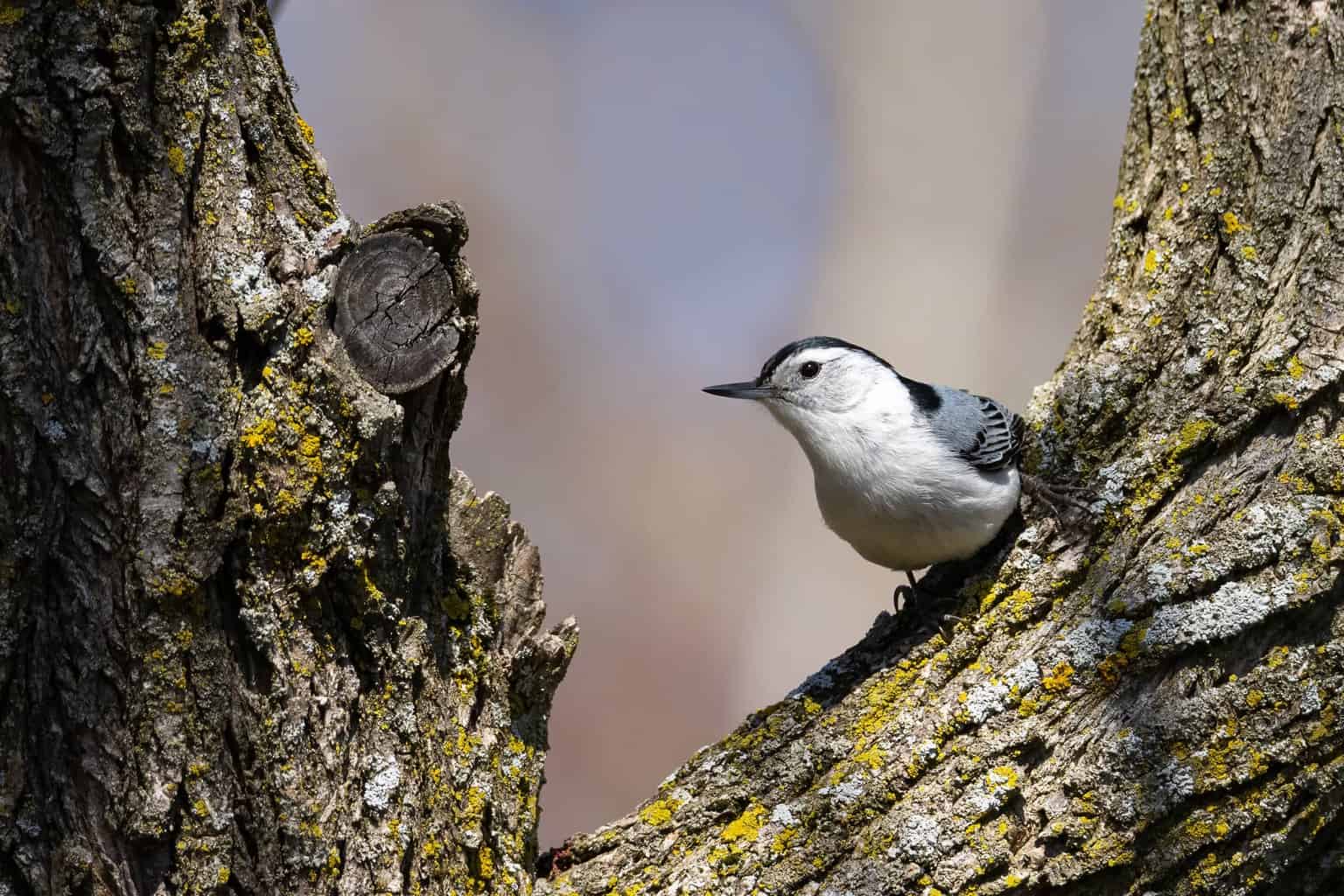
- Scientific name: Sitta carolinensis
- Length: 5.1 to 5.5 inches
- Weight: 0.6 to 1.1 ounces
- Wingspan: 7.9 to 10.6 inches
Another widespread bird that you can find in Oklahoma is the White-breasted Nuthatch. This bird is known for its blue-gray back, with the coloring extending to its rump and head.
The rest of the bird is covered in white feathers, including the breast and underparts. The White-breasted Nuthatch often nests in bird boxes around the backyard, but you can also find them in the wild, especially around deciduous trees.
Purple Martin
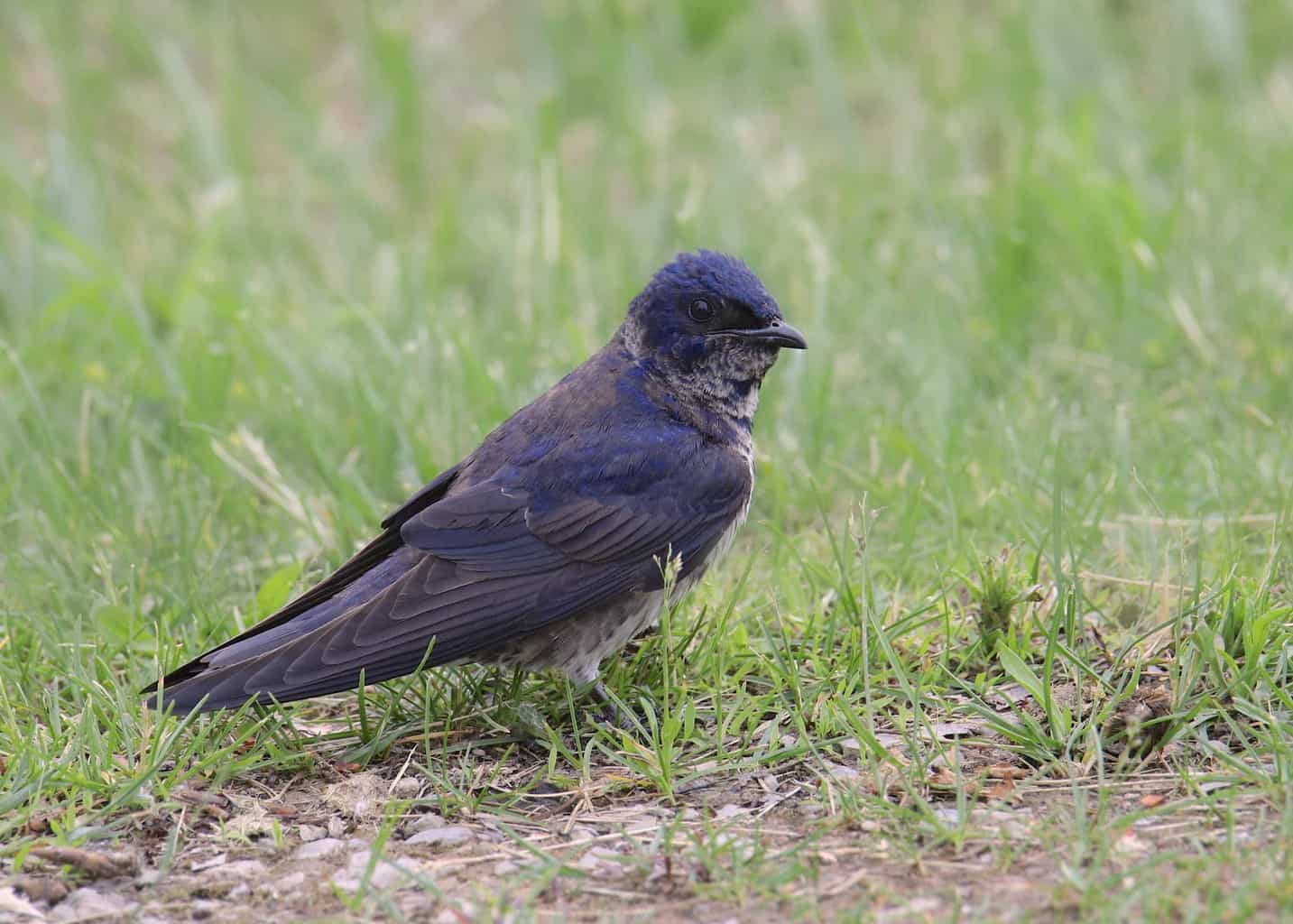
- Scientific Name: Progne subis
- Length: 7.5 to 7.9 inches
- Weight: 1.6 to 2.1 ounces
- Wingspan: 15.3 to 16.1 inches
The Purple Martin is unique in terms of color and behavior. The bird has a mesmerizing purplish-blue plumage that is quite rare.
This color covers the bird’s shoulders and head. However, the rest of the bird’s body is usually dark grey.
The bird typically nests in hollowed-out trees. However, these birds have failed to adapt as more land is cleared for either farming or housing, which has led to a decline in their population, especially in the last century.
European Starling
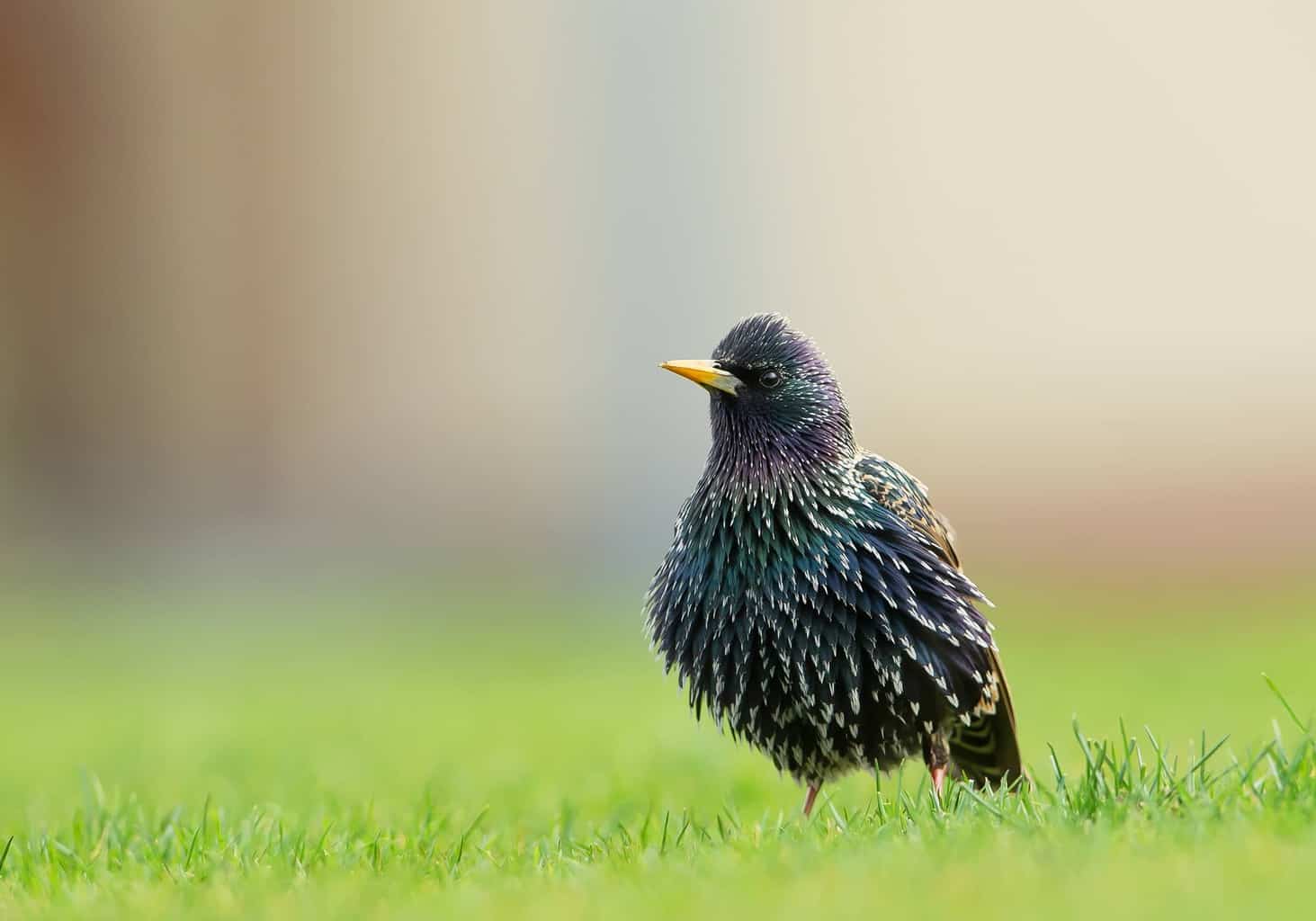
- Scientific name: Sturnus vulgaris
- Length: 7.9 to 9.1 inches
- Weight: 2.1 to 3.4 ounces
- Wingspan: 12.2 to 15.8 inches
Although the European starling isn’t originally a native bird to North America, it has become one of the most common birds nowadays due to its resilient and invasive capabilities.
The bird has a slender body with a unique iridescent dark plumage that shines in hues of green and purple when it reflects sunlight.
The females have a unique pattern heavily spotted with brown patches on the wings and back.
Mourning Dove

- Scientific Name: Zenaida macroura
- Length: 11.8 to 12.2 inches
- Weight: 4.3 to 6.4 ounces
- Wingspan: 17.3 to 18.2 inches
The Mourning Dove is one of the most common species of doves in North America.
The bird has a characteristic buff color all over its body, with bright sky blue rings around its eyes and black spots on its wings.
If you want to attract them to your feeder, make sure you spread millet in your backyard because they typically feed on the ground.
Rock Pigeon
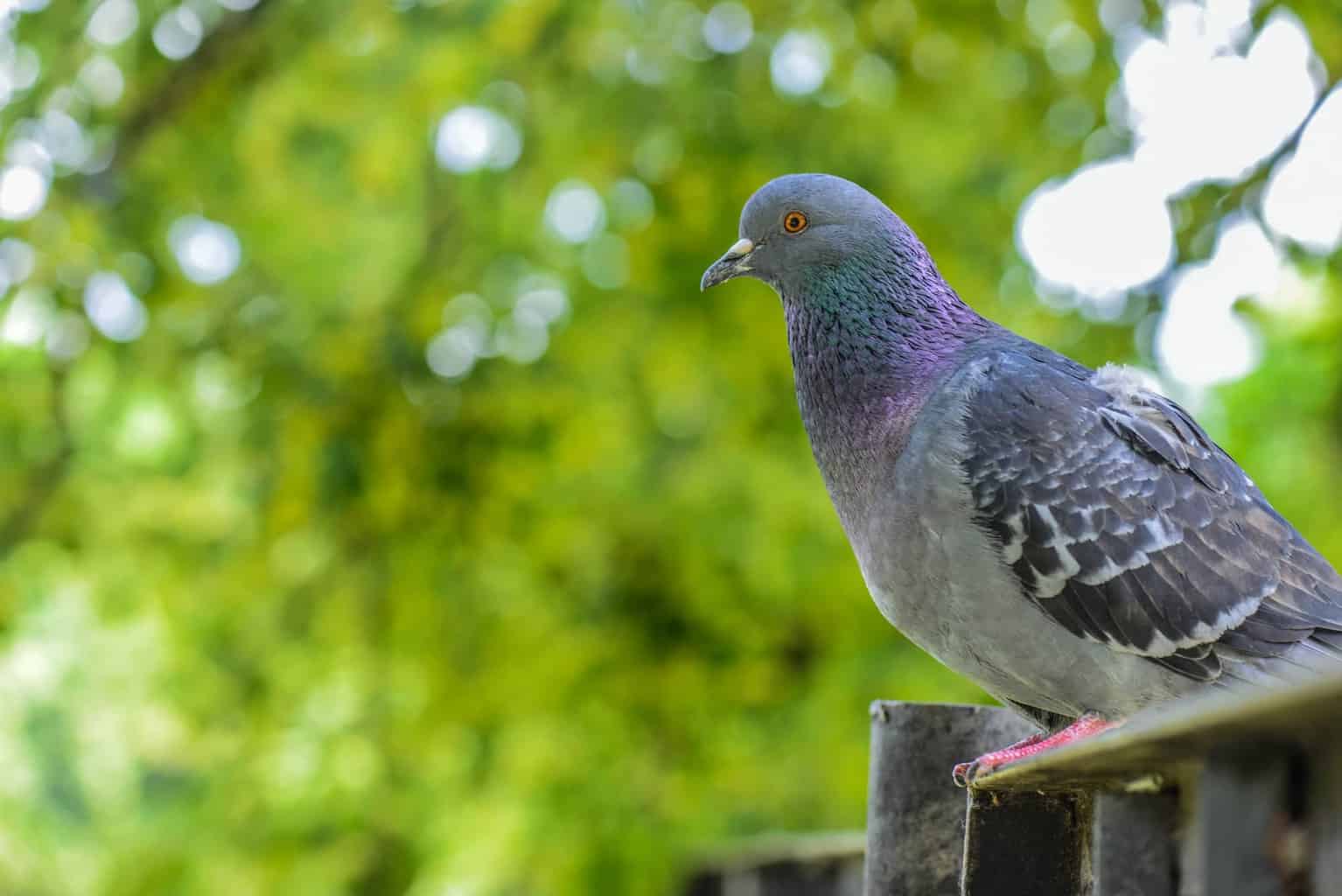
- Scientific name: Columba livia
- Length: 11.8 to 14.2 inches
- Weight: 9.3 to 13.4 ounces
- Wingspan: 19.7 to 26.4 inches
These birds are also known as Rock Doves, and similar to the Mourning Dove, this bird is also a tubby bird that is quite large with distinct coloration.
The birds are acclimated to residential areas, and you can typically find them hanging around rocky cliffs, as well as cities, towns, and even agricultural fields.
The bird is generally gray with an iridescent patch around the neck that shines in hues of green and purple.
Painted Bunting

- Scientific name: Passerina ciris
- Length: 4.7 to 5.1 inches
- Weight: 0.5 to 0.7 ounces
- Wingspan: 8.3 to 9.1 inches
We will end with one of the most heavily colored birds that you may find in Oklahoma. The Painted Bunting has a vibrant pattern of colors with a blue head, flaming red chest, underparts, and yellow and green wings.
Luckily, these shy and elusive birds are attracted to bird feeders filled with sunflower seeds and white millet.
Wrap Up
There you have it! A complete list with a wide variety of the most astonishing and colorful birds that you may come across in Oklahoma.
As you can see, the state’s location at the center of the United States gives it a unique spot that allows it to house a wonderful collection of birds!









